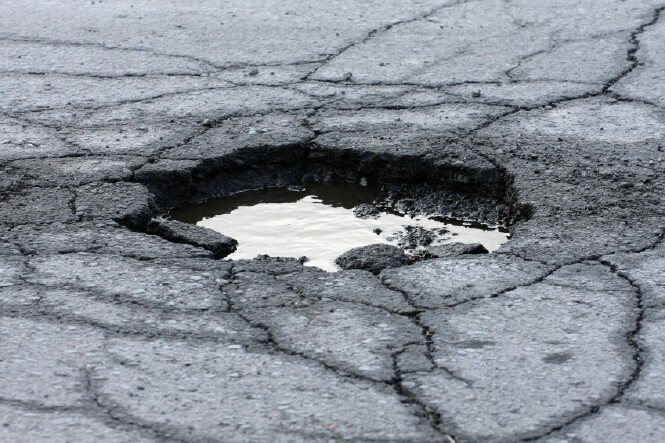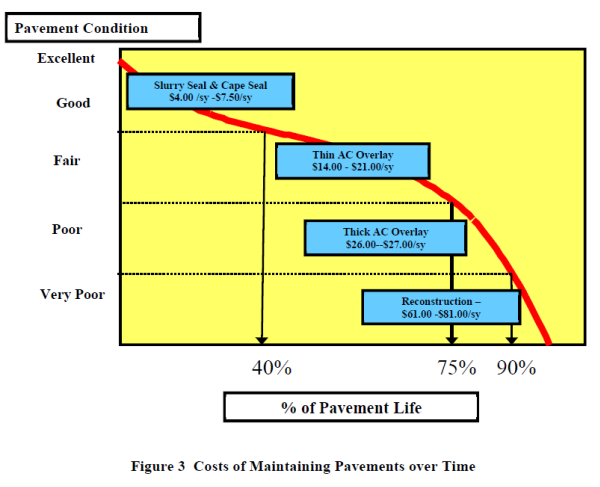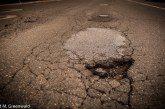
In early February the Nichols report came out showing the city’s Pavement Condition Index (PCI) was far lower than previously believed. The average was 62, which puts the network in the fair condition category with a significant portion of the network suffering from “load-related distresses.”
Previous estimates had the number at 70, still a low number, but not quite the crisis. One of the big differences is that the city had previously surveyed all streets and bike paths using a manual method, where “a person visually inspects each street (or path) segment and conducts a detailed survey of 10% of the segment considered to be representative of the segment’s condition.”
The current street surveys were “using a vehicle equipped with a video or digital camera.”
The images were then analyzed by office staff to gather condition data. This method surveys “one entire lane on residential and collector streets and one lane in each direction on arterial streets.”
“This was done with a machine instead of visually,” said City Manager Steve Pinkerton. “It looked at more of the pavement. It was a larger sample size.”
Using this method, Nichols found the average 2012 PCI to be far lower than previous estimates.
Writes staff, “While the City Council has recently provided additional funds for pavement maintenance, the past five budgets have contained about $1 million per year of total funding with approximately $800,000 per year allocated to streets and $200,000 per year allocated to bike paths. Under this funding scenario, more than half our streets and approximately 26% of our bikepaths will have failed by 2032.”
But even this does not tell the full story. Three years ago, the Vanguard received data that looked at the city on a street-by-street basis.
At that time, the PCI rating was 71 but we warned, “The bad news is that with funding levels as currently projected, our roads will continue to decline.”
In 2010, there were 220 streets in Davis that received failing grades of 59 or below, out of 1021 total streets, with another 150 streets that would likely fall into the failing mark if they were not repaired in the near future.
In three years, and with the advent of the better survey methodology, that number has soared.
Click here to read the full report and see how your street grades.
As of the time of the survey last fall, there were 286 receiving grades of 50 or less and 450 that received grades of 59 or less.

Three years ago, the twenty five worst streets ranged from 1 to 33. Now there are 67 streets that range from 0 to 33.
This shows not just the increased level of scrutiny but the continued decline of the condition of roadways in Davis.
Nichols writes, “”Deferred maintenance” or “Unfunded backlog” consists of pavement maintenance that is needed, but cannot be performed due to lack of funding. These terms are often used interchangeably.
“Shrinking budgets have forced many cities and counties to defer much-needed road maintenance. By deferring maintenance, not only does the frequency of citizens’ complaints about the condition of the network increase, but the cost to repair these streets rises as well.”
Page 10 of the Nichols report that came out in early February lays it out.
They write, “History has shown that it costs much less to maintain streets in good condition than to repair streets that have failed. By allowing pavements to deteriorate, streets that once cost $4/sy to slurry seal may soon cost $14-$27/sy to overlay and $61-$81/sy to reconstruct.”
This is the critical point: “In other words, delays in repairs can result in costs increasing as much as 20-fold.”
Or, graphically depicted, this is what it looks like.

How bad have things gotten? Back in 2011, the council made efforts to get funding levels up to $1 million a year. However, that is not nearly enough.
At the current level of funding, the Nichols report warns, “Based on an existing funding level of $20 million over 20 years, with approximately 3% allocated for preventive maintenance, the condition of the network will deteriorate to a PCI of 27 in twenty years and the deferred maintenance or unfunded backlog will dramatically increase more than ten-fold from $21.4 million in 2012 to $439.4 million in 2032.”
As bad as this picture looks, we do not even have the full picture.
According to the city’s staff report, “The City surveyed approximately one-fifth of the City’s streets each year to evaluate the pavement condition and update our program. The last such survey was conducted in 2009, just before City budget conditions resulted in a 40% loss of transportation personnel, including the City’s pavement maintenance engineer.”
The report notes that some of the city streets have not been surveyed since 2005.
That means that a large chunk of the roadways were not analyzed with the more rigorous method and some have not been analyzed at all in the last eight years.
—David M. Greenwald reporting







these numbers are not getting any less ugly. this is going to be an ugly conversation coming up this spring. don’t think many people in this town realize how much they were sold out by the last council and city manager. a shock is coming.
For a city that prides itself on public art, I suggest looking at the potholes as opportunities for artistic expression and humor, rather than problems:
Embracing Potholes by Turning Them Into Hilarious Imaginative Scenes